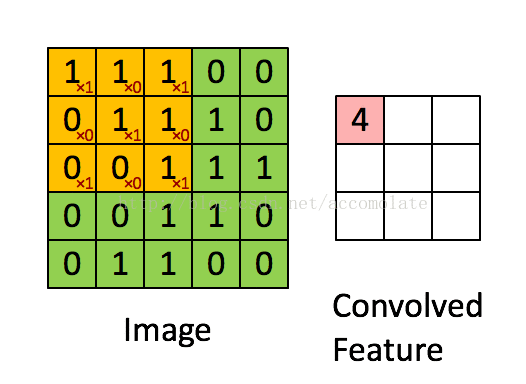这个练习用于处理大型图像,需要编写代码实现卷积特征提取和池化(采样)两个过程。在上一个练习中,通过小尺寸图像样本训练线性编码器得到的权重矩阵W、偏差向量b以及预处理的ZCA白化矩阵ZCAWhite、均值向量meanPatch存为文件STL10Features.mat。此练习利用STL10Features.mat中的特征与大图作卷积生成卷积特征矩阵。
卷积计算在cnnConvolve.m中实现。对每张图像的每个特征(隐藏单元)的每个RGB分量(三层循环),从W中提取对应的卷积核,将其与大图做卷积。这里计算大图与卷积核的卷积与数学中的矩阵卷积不同,是两矩阵的对应项直接相乘再求和,具体过程如下图:
每个RGB分量计算的卷积累加起来,其结果加上特征的偏置后取sigmoid就得到了一张图像的一个特征的卷积矩阵。三层循环结束后就得到了全部图像的卷积特征矩阵族。
cnnConvolve.m
function convolvedFeatures = cnnConvolve(patchDim, numFeatures, images, W, b, ZCAWhite, meanPatch)
%cnnConvolve Returns the convolution of the features given by W and b with
%the given images
%
% Parameters:
% patchDim - patch (feature) dimension
% numFeatures - number of features
% images - large images to convolve with, matrix in the form
% images(r, c, channel, image number)
% W, b - W, b for features from the sparse autoencoder
% ZCAWhite, meanPatch - ZCAWhitening and meanPatch matrices used for
% preprocessing
%
% Returns:
% convolvedFeatures - matrix of convolved features in the form
% convolvedFeatures(featureNum, imageNum, imageRow, imageCol)
numImages = size(images, 4);
imageDim = size(images, 1);
imageChannels = size(images, 3);
% Instructions:
% Convolve every feature with every large image here to produce the
% numFeatures x numImages x (imageDim - patchDim + 1) x (imageDim - patchDim + 1)
% matrix convolvedFeatures, such that
% convolvedFeatures(featureNum, imageNum, imageRow, imageCol) is the
% value of the convolved featureNum feature for the imageNum image over
% the region (imageRow, imageCol) to (imageRow + patchDim - 1, imageCol + patchDim - 1)
%
% Expected running times:
% Convolving with 100 images should take less than 3 minutes
% Convolving with 5000 images should take around an hour
% (So to save time when testing, you should convolve with less images, as
% described earlier)
% -------------------- YOUR CODE HERE --------------------
% Precompute the matrices that will be used during the convolution. Recall
% that you need to take into account the whitening and mean subtraction
% steps
% patchDim 8
% numFeatures 400; is hiddenSize
% images images(r, c, channel, image number)
% W hiddenSize X visibleSize
% b hiddenSize X 1
% ZCAWhite visibleSize X visibleSize
% meanPatch visibleSize X 1
WT = W * ZCAWhite;
bias = b - WT * meanPatch;
patchSize = patchDim * patchDim;
% --------------------------------------------------------
convolvedFeatures = zeros(numFeatures, numImages, imageDim - patchDim + 1, imageDim - patchDim + 1);
for imageNum = 1:numImages
for featureNum = 1:numFeatures
% convolution of image with feature matrix for each channel
convolvedImage = zeros(imageDim - patchDim + 1, imageDim - patchDim + 1);
for channel = 1:imageChannels
% Obtain the feature (patchDim x patchDim) needed during the convolution
% ---- YOUR CODE HERE ----
feature = reshape(WT(featureNum,(channel-1)*patchSize+1:channel*patchSize), patchDim, patchDim);
% ------------------------
% Flip the feature matrix because of the definition of convolution, as explained later
feature = rot90(squeeze(feature),2);
% Obtain the image
im = squeeze(images(:, :, channel, imageNum));
% Convolve "feature" with "im", adding the result to convolvedImage
% be sure to do a 'valid' convolution
% ---- YOUR CODE HERE ----
convolvedImage = convolvedImage + conv2(im, feature, 'valid');
% ------------------------
end
% Subtract the bias unit (correcting for the mean subtraction as well)
% Then, apply the sigmoid function to get the hidden activation
% ---- YOUR CODE HERE ----
convolvedImage = sigmoid(convolvedImage + bias(featureNum));
% ------------------------
% The convolved feature is the sum of the convolved values for all channels
convolvedFeatures(featureNum, imageNum, :, :) = convolvedImage;
end
end
end
function sigm = sigmoid(x)
sigm = 1 ./ (1 + exp(-x));
end
池化采用平均采样。对每个卷积特征矩阵划分为若干个池化区域,每个区域取特征均值作为一个采样特征。在采样特征上做Softmax分类及测试。
cnnPool.m
for imageNum = 1:numImages
for featureNum = 1:numFeatures
temp = conv2(squeeze(convolvedFeatures(featureNum,imageNum,:,:)),ones(poolDim)/poolDim/poolDim,'valid');
pooledFeatures(featureNum,imageNum,:,:) = temp(1:poolDim:end,1:poolDim:end);
end
end





 本文详细介绍了如何使用预先训练的特征在大型图像上进行卷积操作,生成卷积特征矩阵,并通过平均采样进行池化处理。重点阐述了卷积过程中的矩阵运算与池化技术的应用,旨在提升图像识别与处理效率。
本文详细介绍了如何使用预先训练的特征在大型图像上进行卷积操作,生成卷积特征矩阵,并通过平均采样进行池化处理。重点阐述了卷积过程中的矩阵运算与池化技术的应用,旨在提升图像识别与处理效率。


















 被折叠的 条评论
为什么被折叠?
被折叠的 条评论
为什么被折叠?








